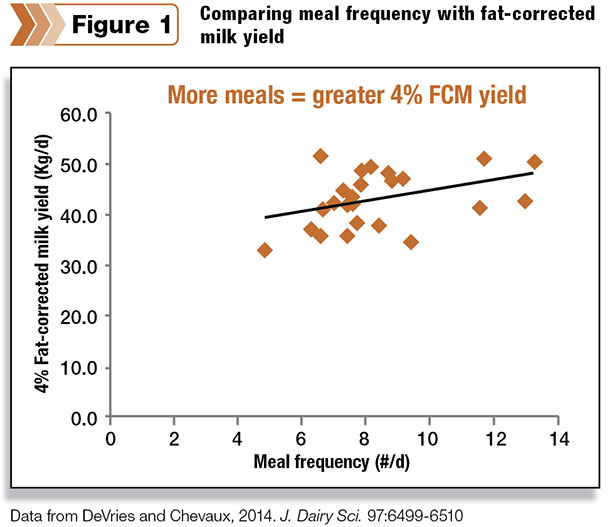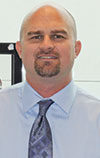You know the routine – as soon as the tractor starts, every cow on the farm gets up and rushes the feedbunk. By the time the feed arrives, all the animals are waiting impatiently and acting like they haven’t been fed in days.
Dr. Trevor DeVries, one of the leading experts in dairy cow feeding management from University of Guelph, declared this situation should signal that something is wrong and you should consider more frequent feed deliveries or pushups.
I anticipate the next big revolution in our industry will be in this arena – collectively known as feed manipulation.
However you define outstanding performance for your dairy, it all starts with the basics. Those basics include keeping food in front of your cows at all times to help ensure top milk quality from the very beginning.
Cows cannot eat what they cannot reach or do not have. You should seriously consider implementing effective feed manipulation on your dairy for the following reasons.
Higher DMI
Dry matter intake (DMI) is everything. The more your cows eat, the more milk they are able to produce. Additionally, ration consistency is critical. Studies show that as ration consistency varies, dry matter intake suffers, which may result in lower milk production.
Even if your farm excels at mixing and delivering the total mixed ration (TMR) to the feedbunk, it will still be sorted by the first cows to eat. Therefore, submissive cows that eat later will not receive the same consistent ration. Observe a cow’s eating behavior; within minutes of arriving she will create a large hole as she sorts through the feed.
Now ask yourself: Do you want that cow to back out and find another spot at the feedbunk? A far better option is to stir up the remainder and push it back under her nose. This is most critical for transition cows that are most vulnerable to going off feed and are often regrouped several times within a short time period.
Improved butterfat
More meals per day can result in approximately a 4 percent increase in fat-corrected milk (Figure 1). Additionally, according to DeVries, fewer, larger meals result in a higher risk for subacute ruminal acidosis (SARA). Longer feeding times and a slower feeding rate will result in a more stable rumen environment and decrease the risk of SARA.

When cows rush the feedbunk, they do so because they are hungry and prefer the fresh feed, similar to a person not eating breakfast and then “pigging out” at lunch. They will feel lethargic and may have a stomachache. The same holds true for cows, with the added effect of disrupting the pH balance of the rumen, which then may lead to butterfat depression.
The best way to get cows to eat more frequent, smaller meals is to create as many feeding stimulation points across the day, such as feeding more frequently, pushing up feed frequently and staggering these events across the day and night.
Less refusals
One of the things I observe when working with herds that frequently push feed is a significantly lower refusal rate. I compare this to eating crab legs. They are a delicious meal, but you can starve to death trying to open them. There are many times I won’t order them because I don’t want to exert the extra effort.
If the cow has to work too hard she will eventually lie down and wait for the feed truck to return. The feed that was not pushed up will be wasted.
Another observation I have made in my travels is that frequent feed pushup helps keep the feedbunk clean and the food fresh. After the cow has finished eating, the scattered feed creates a large surface area for oxygen to degrade the forage.
Continuously pushing the feed keeps it in a neat pile that helps prevent heating and shrink.
Longer standing after milking
According to DeVries, an optimal time for a cow to eat is immediately after milking to increase her standing time. A cow that stands longer allows more time for the teat canal to close, reducing the risk for mastitis. Therefore, in a perfect world the feed should be manipulated just prior to cows exiting the parlor.
While this is a logistical challenge, be aware of the ideal situation and strive to achieve it. Current technologies exist that automate feed manipulation and ease or eliminate those challenges.
Better robotic traffic
Robotic milking is driving the automatic feed pusher revolution for many reasons. The simplest reason is that herd management data is more detailed and individualized, so any return on investment can be more easily calculated. Another reason is enhanced cow traffic through the robot.
If all cows get up and rush the feedbunk at once, they may then start queuing up in front of the robot. Frequent feed manipulation allows the herd to get in a very consistent rhythm with a more consistent throughput.
Another observation I have made on robotic farms is the same cows tend to go to the same place along the feed fence.
Often the four or five stanchions closest to the robot will always have cows eating, so it is critical to allow those cows equal access to feed around the clock. In my opinion, any farm milking with robots should use an automatic feed pusher.
In real life, dairy farms are susceptible to life’s everyday challenges such as absent employees, equipment breakdowns or some other form of crisis. I think most farmers and their advisers will agree that feed pushup does not always happen as intended.
Automated technologies exist that enable feed pushing around the clock, up to 24 times per day. Automatic TMR feeding systems that deliver feed eight to 10 times per day and require minimal labor to help take human inconsistency out of the equation are starting to hit the market.
Increasing the frequency of feed manipulation is becoming a hot topic in the dairy industry. When looking at the benefits for you and your cows, it’s easy to see why. By keeping quality feed in front of them at all times, you can help manage your herd so the cows have a healthy and productive life. PD
PHOTO: Increasing the frequency of feed manipulation is becoming a hot topic in the dairy industry. Photo courtesy of Jim Mattox.

-
Jim Mattox
- Solution Manager – Feeding Systems and Nutrition
- DeLaval North America
- Email Jim Mattox







